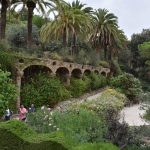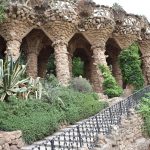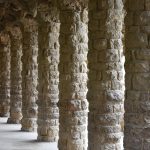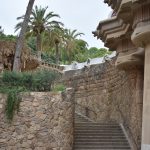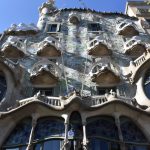As the UNESCO comments:
Seven properties built by the architect Antoni Gaudí (1852–1926) in or near Barcelona testify to Gaudí’s exceptional creative contribution to the development of architecture and building technology in the late 19th and early 20th centuries. These monuments represent an eclectic, as well as a very personal, style which was given free reign in the design of gardens, sculpture and all decorative arts, as well as architecture.
His work is rooted in the particular character of the period, drawing on the one hand from traditional Catalan patriotic sources and on the other from the technical and scientific progress of modern industry. Gaudí’s work is a remarkable reflection of all these different facets of society and has a unique and singular character. In fact, his works are particularly associated with Modernisme, and in this sense, Gaudí can be regarded as the most representative and outstanding of the Modernista architects.
Gaudí’s work is an exceptional creative synthesis of several 19th-century artistic schools, such as the Arts and Crafts movement, Symbolism, Expressionism, and Rationalism, and is directly associated with the cultural apogee of Catalonia. Gaudí also presaged and influenced many forms and techniques of 20th-century Modernism.
在巴塞罗那市区或近郊的7处安东尼·高迪的建筑作品,见证了他对19世纪末和20世纪初建筑技术的杰出创意与贡献。圭尔公园、圭尔宫、米拉大楼、文生宅圣家大教堂、巴特里奥之家和克洛尼亚古埃尔宫,这些建筑物都呈现了折衷主义风格,非常人性化,这对花园、雕塑以及所有装饰艺术和建筑的设计产生了极大影响。
(Below is the general introduction of a series of 6 posts about the 7 works by Antoni Gaudí protected by the UNESCO in and around Barcelona. If you have already read my first post “Works of Antoni Gaudí (1/7) – La Sagrada Familia” please skip the introduction part and jump below the horizontal line.)
In total there are 7 properties designed by Antoni Gaudí which are inscribed in the UNESCO World Heritage list. They are, Gaudí’s work on the Nativity façade and Crypt of La Sagrada Familia, Park Güell, Palau Güell, Casa Mila, Casa Vicens, Casa Batlló and Crypt in Colonia Güell.
Luckily, many thanks to the developed tourism industry of Barcelona, I was able to visit almost all the properties except Casa Vicens, which was still under reconstruction. It was a pity that I could only take a look at the exterior of the building but later on I read more about the interior on books. Hopefully when you visit Barcelona, the door of Casa Vicens will be open to you already.
In order to provide an insight into how to explore the works of Gaudí in a more organized manner, I’d like to write about these 7 properties in 6 not-too-long posts, namely “la Sagrada Familia”, “Casa Mila”, “Casa Batlló”, “Park Güell”, “Palau Güell”, “Crypt in Colonia Güell and Casa Vicens”, just in case if you only want to visit some of the 7 buildings, you don’t need to scroll down a super-long post to find out where to go or what to see.
My general structure of introducing these properties would be first of all, some practical information based on my own experience such as opening hours and buying tickets. Secondly, I’ll focus on what I’ve learnt from my visit (audio guide or books) and I’ll try offering some highlights combined with pictures. I believe in this way, it’s easier to understand the cultural and historical value of Gaudí’s works and his influence. If you have any questions, please do not hesitate to contact me or contact the Tourism Office of Barcelona directly, I assure you they will handle your questions or requests efficiently. Now, let’s start our journey of exploring the masterpieces of God’s architect, Antoni Gaudí.
Before exploring this park, let’s first of all take a look at the reason why it was built. Did you know that Güell park wasn’t really planned as a park? At the climax of Spanish industrial revolution, Barcelona’s population has extended beyond the old town and its city walls. As the Universal Exhibition 1888 revealed to Europe, “Barcelona, an industrial metropolis that was very socially conflictive”. The financier Eusebi Güell saw the opportunity and decided to build an Eden park outside the center of Barcelona.
When he entrusted Gaudí to create an estate for the well-off families in Barcelona, the setting with splendid views over the sea and the plain of Barcelona is unbeatable. However, the area he chose to build the estate on was called the “bald mountain“, with rugged landscape and lack of flora. Just back from his trip in England, he was fascinated by the idea of “Garden City“, which was really a hit all across Europe at that time. He expected this place to be immersed in nature, in health and far from the noise of big city, bringing the best of rural and city life in one area. His idea was to build a private residential estate with abundant plants and a few houses inside a protected enclave, which guarantees the residents’ privacy and quietness.

Was this a tough task or was he too demanding considering the conditions of that area? I would say yes but fortunately, he chose the right architect, Antoni Gaudí, who turned this “bald mountain” into Utopia. The relationship between them is much more than the relationship of an artist and a patron, but true friendship. Both of them had a solid humanistic background and deep religious convictions, and shared a deep-rooted Catalanist patriotism, and this is why the symbols here in this park are usually connected to classical Greece, the Christian tradition and Catalonia (I’ll explain more in the second chapter when I talk about visiting the monumental zone). Güell and Gaudí thoroughly discussed the design and planing of this future residential complex and agreed on giving it a symbolic value that would turn back to “Christian values and Catalan traditions as a way of combating the alienation of the new industrial society”.

Accepting this commission, Gaudí was faced with a huge amount of building work because this is not about one single house, palace or church but a residential complex. In order to keep building at an efficient pace and to avoid the impression of the visitors that this park is a “mass-produced” project, Gaudí chose to design prefabricated-concrete modules in different shapes, covering them with trencadís, in a variety of colors and textures. Based on the combination of naturalism and symbolism, beauty and practicality, he designed the paths, viaducts, bridges, steps, a main plaza, a hypostyle hall (used as a market place), a tank to collect rainwater and two gate houses (the administrative offices and caretaker’s lodge). I’ll give you a more detailed introduction and explanation about them in chapter two.
Unfortunately this project failed as a residential estate due to the exclusive nature and the lack of proper transport. (Many thanks to Park Güell, who contacted me for some more detailed reasons that resulted in the failure of this project as a residential estate and how this estate turned to be a public park in the end. Please read more about it at the end of this post)



1. Practical information
1.1 Opening hours
High season (spring-summer)
From 1st May to 27th August: 08:00 – 21:30 (last entry at 20:30)
Mid season (spring)
From 26th March to 30th April: 08:00 – 20:30 (last entry at 19:30)
Mid season (summer-autumm)
From 28th August to 28th October: 08:00 – 20:30 (last entry at 19:30)
Low season (winter and autumn)
From 1st January to 28th or 29th February: 08:30 – 18:30 (last entry at 17:30)
From 1st March to 25th March, extended hours to 19:00h (last entry at 18:00)
From 29th October to 31st December: 08:30 – 18:30 (last entry at 17:30)
Please note that this schedule corresponds to 2017 season. Every year the schedule will be modified in order to adapt to sunlight. It is always recommended checking the official website to see the updated opening times.
1.2 Various ticket prices
What you need to know is that Park Güell is a big park and only for entering the monumental zone are you required to have the entry ticket below. Is it worth it visiting the monumental zone? My answer id absolutely yes.
For buying tickets on site (at the ticket offices or ATMs), the prices are:
- General ticket: 8 €
- Children from 0 to 6 years old: 0 €
- Children from 7 to 12 years old: 5,6 €
- Over 65 years old: 5,6 €
- Disabled person + accompanying person: 5,6 €
For buying tickets online, the prices are:
- General ticket: 7 €
- Children from 0 to 6 years old: 0 €
- Children from 7 to 12 years old: 4,9 €
- Over 65 years old: 4,9 €
- Disabled person + accompanying person: 4,9 €
If the ticket is purchased at the ticket offices or ATMs located in the Park itself or at “Lesseps” or “Vallcarca” metro stations (L3), the availability will be subject to the number of visitors already in the Park, up to a maximum of 400 people every half an hour. I was there early in the morning and I saw that tickets were only available for two time-slots before 10:00 for that day so I guess if you arrive later, it’s possible that the tickets would be sold out and you won’t be able to visit the monumental zone. Considering this fact, I suggest you book your tickets online. Please click here to reserve your tickets on the official website.
If you arrive with a printed ticket or show the QR code on your smartphone or tablet, you can go straight to the relevant entry points (check the map because there are several entry points). Tickets are assigned on the basis of time-slots, and you can enter the Monumental Zone up to 30 minutes after your allocated start time. If you wanna collect your tickets from the ticket offices, you’d better arrive a bit in advance, taking the waiting time in the line into consideration.
Be careful that even if your children are legitimate for free tickets, you have to get the free tickets because they are accounted for in the total capacity. You can’t just enter the monumental zone showing your children’s ID cards.
1.3 Guided tours
There are in total two kinds of guided tours here in Park Güell, that is to say the general guided tour and the private guided tour.
1.3.1 General guided tour:
- Groups of maximum 25 people.
- The guided tour lasts approximately 50 minutes.
- Price: €7 per person + Ticket to the Monumental Zone
- Children from 0 to 6 years old don’t need to pay for the guided tour but don’t forget to obtain a free ticket to enter the monumental zone.
- Languages: English, French, Catalan and Spanish.
- Meeting point: Carretera del Carmel, number 23
- For more information about the available time slots please click here and scroll down to the bottom.
1.3.2 Private guided tour:
- Minimum 2 people and maximum 5 people.
- The guided tour lasts approximately 50 minutes. Available up to 48 hours in advance.
- This tour includes: Skip the line + Discover the unknown about Park Güell
- Price: 36€ per person + Entry to the Monumental Zone
- Children from 0 to 6 years old don’t need to pay for the guided tour but don’t forget to obtain a free ticket to enter the monumental zone.
- Languages: English, French, Catalan and Spanish.
- Available times: Weekdays: 9:00, 12:30, 18:30 and 19:00. Weekends and holidays: 9:00, 18:30 and 19:00
- To learn more about tours for more than 5 people, or in different languages, please contact Park Güell authorities directly through this email address (visitesparkguell@bsmsa.cat)
For booking either the general guided tour or the private guided tour on the official website please click here.
As contacted and suggested by Park Güell, you can also download the free official App of Park Güell on your smartphones through Play Store or Apple Store. It is available in seven different languages (Catalan, Spanish, English, French, German, Russian and Japanese) and works as an audio guide.
1.3 How to get here
In general there are 3 main entrances to Park Güell. One at Carrer d’Olot (main entrance), one at Carretera del Carmel No. 23, where there is also the coach park for tourist coaches, and a third one on Passatge de Sant Josep de la Muntanya, which you can get to by taking an escalator.
Address: 08024 Barcelona, Spain
Metro:
Line 3 to station Vallcarca or Lesseps.
From either of these two stops, there’s a 15-min walking distance till the entrance to the park. I suggest that you take the escalator on Baixada de la Glòria, and then go to the entrance on Passatge de Sant Josep de la Muntanya.
Barcelona Tourist Bus:
Bus Turístic (blue line) and Barcelona City Tour the stop is “Park Güell”.
In both cases, the stop is located on Travessera de Dalt, it takes 10 minutes to walk to the park, and it is recommended going either to the Carrer Sant Josep de la Muntanya, which has an escalator, or Carrer d’Olot entrance.
Bus:
Line H6 and Line 32. From the bus stop on Travessera de Dalt, it takes 10 minutes to walk to the park, and it is recommended going either to the Carrer Sant Josep de la Muntanya, which has an escalator, or Carrer d’Olot entrance.
Line 24 and Line 92 to Carretera Carmel-Park Güell stop.
Please note that Carretera del Carmel, Carrer d’Olot and Avinguda de Sant Josep de la Muntanya are the names of the access to Park Güell. However, they are not the entrances to the Monumental Zone. Access to the Monumental Zone is located at the yellow dots. Yellow area corresponds to Monumental Zone and green one is the free access area of the park. Please have a look at the map below provided by Park Güell official website to have a clearer idea of the orientation.

If you still have questions, please don’t hesitate to contact me or click here to contact the official website of Park Güell.
2. Explore the monumental zone of this “Eden Garden”
Before entering this Utopia, I strongly recommend you to obtain a brochure called “PARK GÜELL Visit to the Monumental Zone” available in various languages. If you didn’t book a guided tour, this brochure will be your guidebook and it includes a map with a suggested visiting route and highlighted attractions with explanations. Of course you can obtain the same information from the info boards at each attraction but isn’t it better to have all of them together in your hands than spending time looking for each of them on separate sites?
Suggested by Güell, Gaudí applied the symbolic elements all the way from the gatehouses to the summit of the park as a path of Christian purification. From the porter’s lodge to the monumental flight of steps, from the hypostyle room to the main square, from the portico of the washerwoman to the ramp, let’s explore this park step by step and discover the symbolism and naturalism of Gaudí.
2.1 The main entrance and porter’s lodge



The main entrance has some iron gates which were brought from Casa Vicens. The two pavilions on both sides were the porter’s lodge of the estate. The one on the left, used receive visitors to the estate is now a book shop and the one on the right, used to be the keeper’s house is now part of Barcelona History Museum. You can enter for free from the monumental zone because the price is included in your ticket. However, there might be some waiting time because it’s a rather small house compared to the amount of visitors it receives. The chimneys of them are designed in the shape of a mushroom, usually connected to the world of magic or fairytales.
It is here that you will see “Park Güell” written in English on the wall of the keeper’s house pavilion, proving the influence of “Garden City” from England. On top of this pavilion, if you take a close look you will notice that the white scales are actually made of inverted coffee cups. Due to the bent, twisted surface, a decorative technique much loved by Gaudí, was used. It’s called trencadís, meaning using mosaic of pieces of ceramic previously broken into small tiles, often taken from demolition materials and disused objects. Also, beloved by Gaudí and other Catalan architects during the Modernism movement, the Catalan vault is visible here in these pavilions. It is a type of low arch made of plain bricks often used to make a structural floor surface. “It is traditionally constructed by laying bricks lengthwise over a wood form or “centering”, making it a much gentler curve than has generally been produced by other methods of construction.”
2.2 Monumental flight of steps



The steps start from the entrance square and lead to the Hypostyle Room. It is a double flight of steps divided by a few sculptural features, among which the most curious ones are the snake and eucalyptus fruits, the dragon and the stone omphalus. Along the way you climb up, you will see the fountain in the form of the head of a snake on the shield of Catalonia. The snake and eucalyptus fruits are symbols of medicine and health, like the remedial mineral water found in the park commercialized by Güell. Then you will encounter the bright-colored dragon, whose appearance was much fiercer when the paws and teeth were more noticeable long time ago. This dragon has also become one of the most important icons of Park Güell or even the works of Gaudí. On the top is the tripod which seems to be formed by three snakes, within which the stone might symbolize the Sacred Omphalos Stone.
2.3 The Hypostyle Room




This is a covered area with 86 striated columns crowned by an entablature of classical styles. However, above the cornice, standing out for its curious shapes and colors, is the ceramic bench of the Nature Square. The outer columns slope together with the roof in an undulating movement clearly brings a contradiction to the classical composition.
The Hypostyle Room was designed as a market place for the purpose that the residents here don’t need to leave the estate to look for supplying. As you might recall, it is inspired by the temples of ancient Greece. The regular layout of the dense colonnade is interrupted at certain places to create 3 open space, one large one in the center and another two small ones on the sides. The ceiling, similar to the ones in the pavilions at the entrance, was built using the Catalan vault technique clad with tile shards.
Don’t forget to raise your head when you’re inside this hypostyle to see the ceramic soffits, depicting the sun (there are in total four of them) based on the colorist interpretations. They were designed by the collaborator of Gaudí, Josep Maria Jujol, and were made with unusually shaped and colored materials.
2.4 The Nature Square (main square)



Nature Square, also known as Theatre Grec or Nature Theatre was originally designed for holding open-air shows and for the residents to meet. Unlike the rest of the park, adapted to the terrain, this square is partly dug into the mountain and partly held up by the hypostyle columns. In the first decade of the 20th century, all sorts of celebrations were held here, varying from sports events to social events.
Planned by Josep Maria Jujol, this more-than-100-meter-long bench encloses the entire plaza and functions as a place to sit as well as a balcony and viewpoint over the city. This undulating bench is made of prefabricated blocks of concrete clad covered in trencadís mosaic and can be considered one of the first abstract artworks. Why not taking a seat on this beach since you’ve come so far already? Once you sit on it you will notice its not just a flat bench but with shapes and movements. Of course, the comfort of the residents was taken into consideration. When you are walking on this sandy “esplanade”, it’s not difficult to notice some holes. This is because the square is a collecting point for rainwater. The water will then be channeled through the columns and taken to a tank under the hypostyle. The outlet? You’ve seen it already. Yes, the outlet is the dragon we see when we were on the flight of steps.
2.5 The portico of the washerwoman




Backing onto the retaining wall of the upper roadway, the portico is made from unhewn limestone excavated from this mountain. As you can see from the first picture, popular tradition has seen in this sculpture a figure of washerwoman with a basket of clothes over her head. While walking along the portico, pay attention to the flowerpots on top of the columns. They are covered with stones from the site and seem to have emerged from the ground by themselves.
2.6 The ramp


The steep slope terrain of the hillside where the park is built on required the architect to design a series of viaducts supported by columns, if the natural slopes are to be kept. Always emphasizing on the harmony between nature and architecture, Gaudí made a perfect example of the integration of the two factors. Therefore, the portico of the washerwoman ends in a spiral ramp, an elegant dual-height structure, merging the lower and upper balconies. In order to add a more natural appearance to the structure, it’s clad in unhewn limestone quarried on site, like the porticoes.
Do keep in mind that the monumental zone is just part of Park Güell and if you have time, the rest of the park can be accessed without charge at anytime. Outside the monumental zone, I strongly recommend the pink “Show Home” for the estate, where Gaudí lived until shortly before his death, now the Gaudí House Museum. I’ll write more about this museum in the post which focuses on the museums and experience centers related to the life and works of Gaudí.

Some other important houses or attractions in and around the monumental zone include the Austria Gardens, Casa Trias and Casa Larrad, after being retouched a little by Gaudí, turned into the residence of Eusebi Güell and his family. (Many thanks to Park Güell team again, who commented and provided more information about the model house, Casa Trias and Casa Larrad, please read it by the end of this post).
For Gaudí, one of the greatest challenges he faced was the design of paths in the park as it went beyond the scope of architecture, to the filed of town planning. However, after a walk in the monumental zone, you will discover that this genius can really succeed in every aspect when it comes to building something, whether it’s a residential building, a church, a college, a palace, a residential complex or a park. Come and experience by yourself how Gaudí turned this rugged mountain into a world of magic and beauty.
This post is one of my 6 posts concerning the 7 Works of Antoni Gaudí protected by the UNESCO. If you are interested, please click on the following properties to read more about them.
- Nativity façade and Crypt of La Sagrada Familia
- Casa Mila
- Casa Batlló
- Park Güell
- Palau Güell
- Crypt in Colonia Güell and Casa Vicens
Here by the end of this post, I’d like to express my sincere gratitude to Park Güell team, who read through my entire post carefully and made comments, suggestions and provided more information that I had previously neglected while writing about the park. Contacted by them, I hereby quote some additional information related to the history of the park.
Park Güell project failed because of different reasons, such as the exclusive nature and the lack of proper transport. It was expected to sell 60 plots to different well-off families. However, the conditions of construction were highly restrictive, as only one-sixth of the plot could be built upon and the height and placement of the houses was ordained so that they could neither block the view of the sea nor deprive neighbors of sunlight. The complicated conditions for sale of the plots, under old contracts of emphyteusis (lifetime leasehold), the lack of a suitable transport system and the highly exclusive character of the development all made it unviable. A lack of buyers led to the works being abandoned in 1914, with only two of the sixty houses envisaged having been built. The park thus became a large private garden, which Güell allowed to be used for public events, while it began to appear in tourist guides to Barcelona as one of the attractions of the city.
The two houses built were the model house (now it’s Gaudi’s House Museum, the place where Gaudí used to live with his father and his niece) and the Casa Trias (bought by Güell’s lawyer and friend Martí Trias and nowadays it’s still a private house for the same family). There is a third house that was built before all the project started, known as Casa Larrard and it used to be Güell’s house, where he died in 1918. Nowadays this house is a public school called Baldiri i Reixac.
When Güell died, his heirs offered the park to the City Council, which in the course of its municipal plenary meeting held on 26 May 1922 agreed to purchase it. It was opened as a municipal park in 1926.

